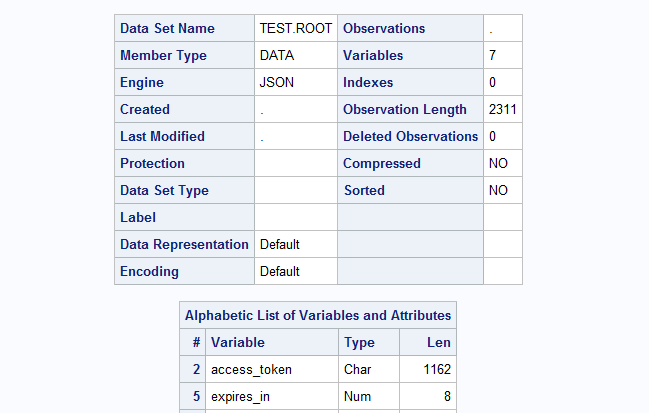
SAS Technical Support often gets requests like the following: "I have this API named <insert name of really cool API here> and I want to process data I get back from the API with SAS. How do I do it?"
In this article, I'll show you how to translate the examples from your API documentation (offered in a select few languages) to the equivalent in SAS.
Test your API with cURL
My first recommendation is to know your API. Most APIs come with documentation and will give specific guidance regarding how to POST data (send) to the API and how to GET data (receive) from the API. Often, examples are provided using cURL commands.
With this information, you are welcome to examine the SAS documentation for the HTTP procedure and build your code. Before you call or email SAS Technical Support asking for PROC HTTP code, I encourage you to verify that you can communicate with your API (or URL) from outside of SAS. One way to do so is with cURL. cURL (Client URL) is a command-line tool that is shipped with many UNIX flavors and installed easily on Windows. With a cURL command, you can interact with your URLs from outside of SAS from a command-line prompt like this:
curl -o "c:\temp\file.txt" -request "https://httpbin.org/get"
From SAS, you can use a cURL command with the DATA step, like this:
data _null_; %sysexec curl -o "c:\temp\file.txt" -request "https://httpbin.org/get"; run; |
File.txt contains the response from the URL:
{
"args": {},
"headers": {
"Accept": "*/*",
"Host": "httpbin.org",
"Range": "bytes=Request",
"User-Agent": "curl/7.46.0",
"X-Amzn-Trace-Id": "Root=1-5f028cd3-2ec7e1e05da1f616e9106ee8"
},
"origin": "149.173.8.1",
"url": "https://httpbin.org/get"
}
However, if you use SAS® Enterprise Guide® or SAS® Studio, you might not have permissions to run operating system commands from SAS, so you need a way to translate your cURL commands to SAS. The previous cURL command is easily translated to the following PROC HTTP code:
filename out "c:\temp\file.txt"; proc http url="https://httpbin.org/get" out=out; run; |
- The -o (OUTPUT) cURL argument translates to the OUT= argument in PROC HTTP.
- The -request argument defaults to a GET for cURL (also the default for PROC HTTP, so METHOD=“GET” is the correct syntax but unnecessary for this step).
- Note: The URL= argument is always quoted.
The cURL command supports many options and features. Check out the cURL reference page. SAS can't guarantee that all are directly translatable to PROC HTTP, but I do want to cover some of the most popular that SAS customers have asked about.
Sending data to an API
If your cURL command uses the -d (DATA) option, you'll use the IN= argument in your PROC HTTP statement. Here I am posting to the URL httpbin.org/post a file called test.csv, which resides in my c:\temp directory:
curl -d "c:\temp\test.csv" -X post "https://httpbin.org/post";
This command translates to the following PROC HTTP code:
filename test "c:\temp\test.csv"; proc http url="https://httpbin.org/post" /* If the IN= argument is used then method="post" is the default */ /* and therefore unnecessary in this step */ method="post" in=test; run; |
Working with authentication
None of the URLs above require authentication, but you'll likely find authentication is part of most APIs. Many APIs have moved to OAuth for authentication. This method of authentication requires the use of an access token, which you obtain with a POST command. With the correct credentials, this cURL command posts to the SAS® Viya® SASLogon REST API in order to obtain an access token:
curl -X POST "https://server.example.com/SASLogon/oauth/token" \
-H "Content-Type: application/x-www-form-urlencoded" \
-d "grant_type=password&username=userid&password=mypassword" \
-u "app:mysecret" -o "c:\temp\token.txt"
The following PROC HTTP code does the same task:
filename out temp; proc http url="http://servername/SASLogon/oauth/token" in="grant_type=password&username=userid&password=mypassword" webusername="clientid" webpassword="clientsecret" method="post" out=out; headers "Content-Type"="application/x-www-form-urlencoded"; run; |
- The -u option is for user ID and password.*
- The -o command/output captures the response, in this case a JSON file. In this case you mimic -o with a FILENAME statement to write the text in JSON format to the WORK library location.
- The -H command is popular and translates to the HEADERS statement in PROC HTTP.
*Read about ways to hide your credentials in Chris Hemedinger's post here: How to secure your REST API credentials in SAS programs.
The output file contains an access token, necessary to make requests on behalf of a client to the REST API. In this example, a cURL command like the following requests a list of folders from the Folders microservice:
curl -X GET "https://server.example.com/folders/folders/@myFolder" \
-H "Accept: application/json" \
-H "Authorization: Bearer TOKEN-STRING"
The PROC HTTP code will look like this if you "directly translate":
filename new temp; proc http url=" https://server.example.com/folders/folders/@myFolder" method="get" out=new; headers "Accept"="application/json" "Authorization"="Bearer TOKEN-STRING"; run; |
But starting in SAS® 9.4M5, there's a shortcut with the OAUTH_BEARER option:
filename new temp; proc http OAUTH_BEARER="TOKEN-STRING" url="https://server.example.com/folders/folders/@myFolder" method="get" out=new; run; |
Processing JSON responses with the JSON engine
I can't tell you about PROC HTTP without a mention of the JSON engine. Starting in SAS® 9.4m4, the JSON engine enables us to easily read JSON files. I can use the previous cURL command to pipe my access token to a file with the -o argument, but using my PROC HTTP code I can easily move that value into a macro variable. I'll add a LIBNAME statement that points to the fileref in the previous step:
libname test json fileref=new; |
I can then examine the contents of the JSON output with this step:
proc contents data=test._all_; run; |
Here I spy the access token I will need for a later PROC HTTP step:

Here's how I can place it in a macro variable:
data _null_; set test.root; call symputx("access_token",access_token); run; %put &access_token; |
So everywhere I used TOKEN-STRING in the previous code, I can now use the macro variable instead, like this:
proc http OAUTH_BEARER="&access_token" url="https://server.example.com/folders/folders/@myFolder" method="get" out=new; run; |
Debugging with PROC HTTP
With the cURL command, you can use the -v (verbose) argument to get connection and header information. It's helpful for debugging and diagnosing trouble spots.
In SAS® 9.4M5, the DEBUG statement was added to PROC HTTP. DEBUG supports several options. I'll highlight the LEVEL= option here:
Level= 0 | 1 | 2 | 3
Selecting 0 provides no debugging information while 3 provides the highest amount of data and messages. Base SAS 9.4 Procedures Guide includes full descriptions of each debug level.
See the HTTP Procedure documentation for additional syntax.
Generating cURL commands with Postman
If you want someone to "write your code for you," I recommend using a product like Postman to test your POST and GET commands with your API from outside of SAS. Postman is an open-source product with a super cool feature: it will produce CURL commands from successful communication with a URL.


Recommended resources
- How to test PROC HTTP and the JSON library engine
- HTTP procedure documentation
- The ABCs of PROC HTTP (conference paper)
- REST Just Got Easy with SAS® and PROC HTTP (conference paper)
- PROC HTTP blog posts: PROC HTTP Archives on SAS Blogs

6 Comments
Hello all together!
Actually the translation from cURL to PROC HTTP in the part "Working with authentication" is not working in my example.
By putting all information together in the in= - statement like
in="grant_type=password&username=userid&password=mypassword&clientid=user&clientsecret=passwort"
instead of
in="grant_type=password&username=userid&password=mypassword"
webusername="clientid"
webpassword="clientsecret"
it worked.
It is confusing to use -u "app:mysecret" in the cURL command and
webusername="clientid"
webpassword="clientsecret"
in the PROC HTTP statement for the authentification anyway or did I missunderstand anything there?
I'm unclear which part is working for you currently, but to be clear: the --user argument (-u) takes both the username and password combined, but PROC HTTP does not have the same functionality. The username and password for basic authenticated urls must be passed with two arguments (webusername and webpassword).
Please clarify if you need more details and thanks for reading!
Like JSON, your article is *pretty* useful 😉 Thanks a lot for sharing. Proc HTTP has nicely evolved over time.
Excellent article! Very helpful. BTW, you may find it a bit easier to display the response JSON to the log using the jsonpp() function. The syntax feels a bit odd because you actually quote the JSON fileref as well as the destination ('log' in this case)
data _null_;
rc = jsonpp('out','log');
run;
Thanks for the tip !
Thanks Carl, that is good stuff!